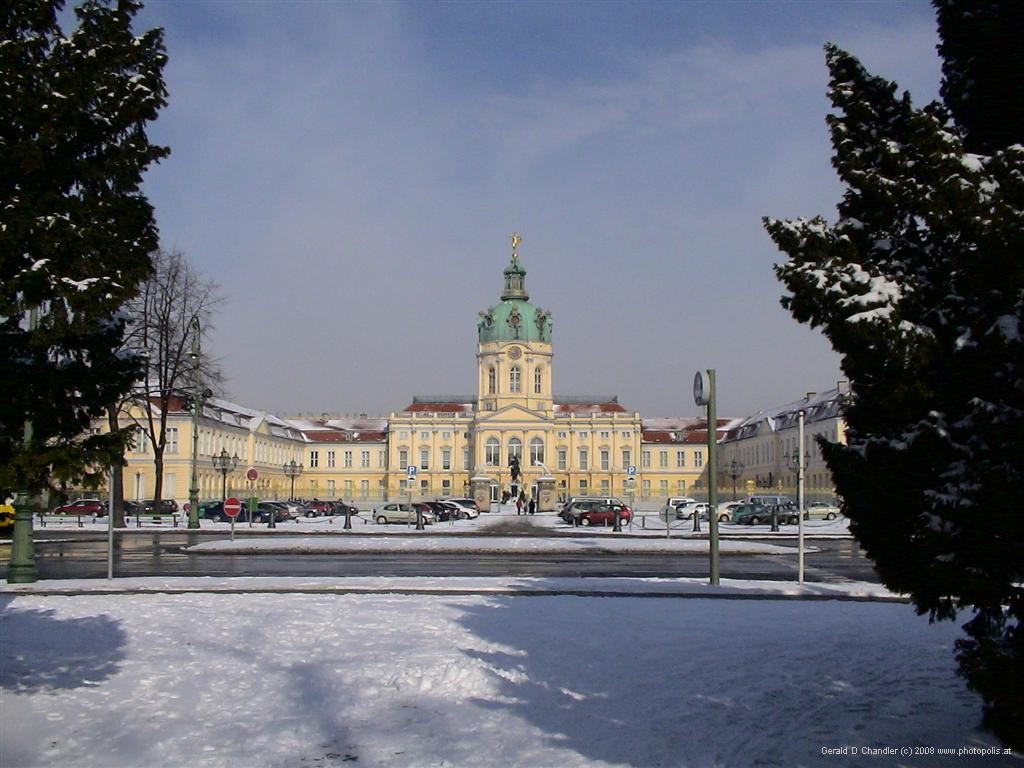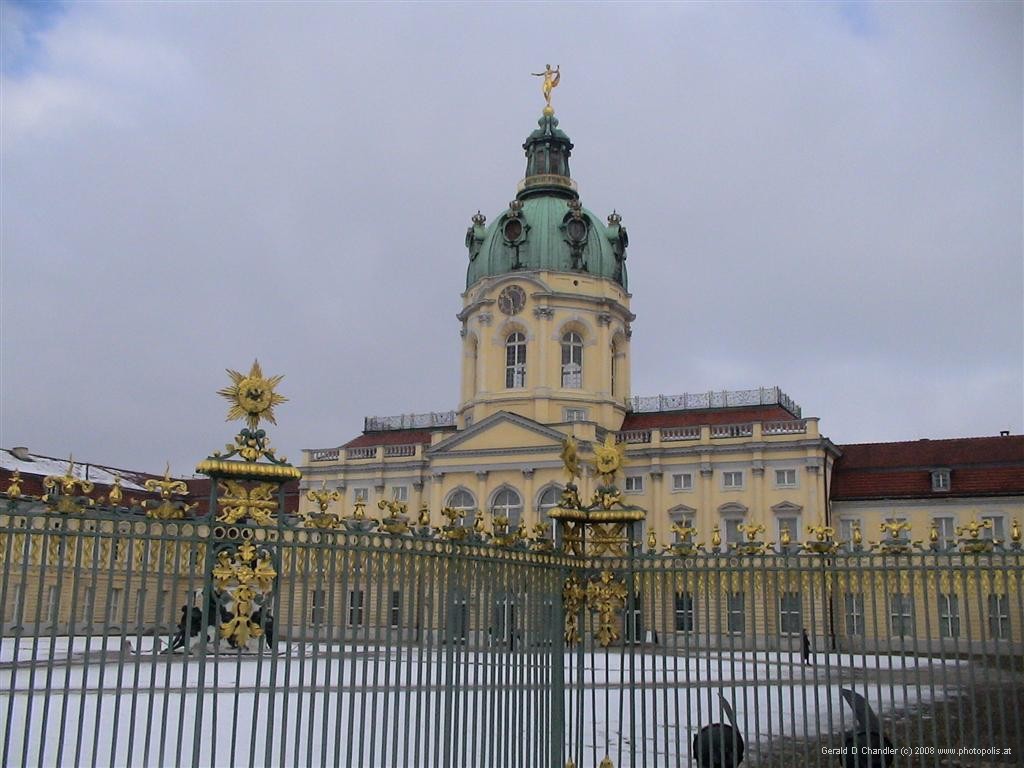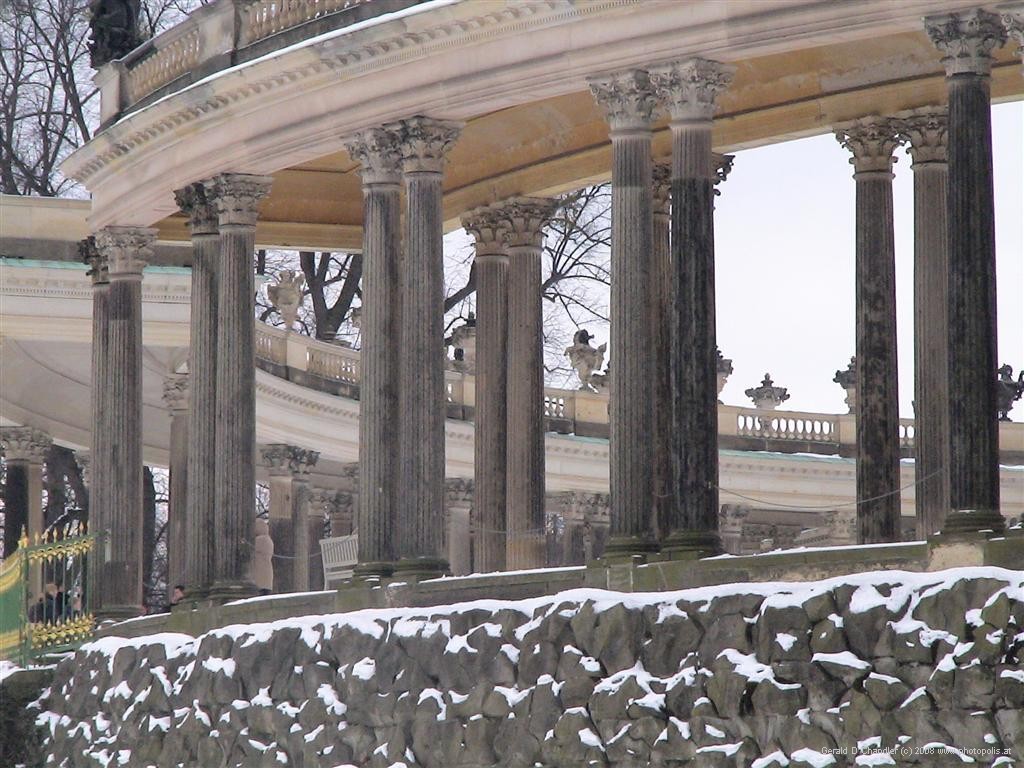Home | Front Page | Index | Blog | New | Contact | Site Map
Winter
Nazi Terror
Churches
Museums
Prussian palaces
Alte Stadt
Modern Architecture
Shopping
Quirks
Bei Uns (At Home)
Guests
Maps
Pics
Foto Show

Palaces
Charlottenburg
Potsdam - San Souci
Potsdam - Neue Palais
Travel 2005
Berlin
Paris
Moscow
Russia
Athens
Travel 2004
Mexico 2004
Belize
Guatemala
Honduras
Costa Rica
Panama
Colombia
Ecuador
From our first week in Berlin we kept hoping that it would warm up so that we could in comfort roam some of its famous places, in particular the palaces of the Prussian Kings. We had hoped by the end of February, almost into offical Spring, we would see signs of buds and warmth. But it wasn't to be. Consequently our visits to the palaces of the Prussian Kings were in cold and snowy conditions. The snow rather added to than detracted from their charm, but we're sure they are more comfortably visited in the other three seasons when the temperatures climb above zero. The photos we have of both palace complexes are limited to exterior views because photography inside was strictly forbidden.
Charlottenburg Palace

Charlottenburg Palace |

Charlottenburg Palace |
Charlottenburg was within walking distance of our place in Kreuzberg, about 8 km or 5 miles. We never made the walk, primarily because of the cold weather and Gerry's trouble with his foot, but if we had we could have had a very pleasant walk along the Landwehr canal to and through the Tiergarten and on to the Castle. The day we did get there we discovered the end of the city walking trail; even in (or because of) the snow it looked rather appealing.
The palace and town are named for Queen Sophia Charlotte, the wife of Frederik I of Prussia (king 1701-1713). It was built in 1695-1699, a period in which royal couples didn't share the same bedroom and often didn't share the same roof. For Frederik to see his Sophia he would have ridden by horse or carriage from his palace in the center of today's Berlin across his private hunting grounds, now the Tiergarten, a public park. The last reminants of that palace were pulled down in an act of rampant destruction by the Communist regime in the 1950s and replaced by a monstrosity, the Palace of Culture. (Fortunately it will soon be gone.)
Once we got our monthly transit pass we took the easy way to Charlottenburg, by U-bahn, and visited the Ethnological (really, pre-history) Museum, housed in the former Orangerie. One of the big attractions of the Palace is its grounds. For us it was too cold to explore more than the edge of them that goes along the back of the main Palace. From there we did get an impression that in Spring or later they would be delightful
We saved visiting the main palace for later, still hoping that Berlin would warm up. As noted, that didn't happen. When Mick and Dinah came to visit we first went with them to the Potsdam palaces and then visited the interior of Charlottenburg. It is a delightful building, although not the one that Sophie-Charlotte lived in. Hers was mostly destroyed in World War II; what we got to see was for the most part an accurate, loving, reconstruction. The tour is done in two parts: The ground floor is seen as part of an obligatory guided tour. This includes impressive state rooms. The second floor is self-guilded; admission includes a self-paced recorded explanation. Which is better is hard to say, since both were good. What sticks most in memory is the large ballroom on the first floor, certainly worthy of a Hollywood romance.
Sanssouci Palace

Sanssouci Palace, Ceremonial Entrance |

Sanssouci Palace, Garden Side |
Everybody needs a country place and kings are no different. The Louis's in France had Versailles and the Fredericks in Prussia had their Palaces in Potsdam. The greatest of them was destroyed in World War II, but two fine ones remain: Sanssouci and the Neue Palais, separated by some large gardens. Potsdam itself is about 30 kilometers from the heart of Berlin, about twice as far as Versailles from Paris. It was the site of a post-World War II conference of the victorious Allies. Today it is an important suburb of Berlin, although it is large enough in its own right that the term seems inappropriate.
Our first palace outing proper was to Potsdam to see the jewel in the crown of Frederick the Great's mansions, the lovely 1745 Rococo Sanssouci (as they write it in German). He built it as a place to get away from it all and it was deliberately small by comparison with the Grand Palace of Potsdam. Being Rococo rather than classical it is less grand but more charming than the Duke of Marlbrough's 1705 Blenheim Palace, the latter built as an emulator of the much larger Versailles. Sanssouci looks out onto the park and gardens that are part of the complex, giving it a warmth from inside. Frederick the Great was a great collector of contemporary art, part of which is displayed on the walls of Sanssouci as it was when he lived there. Sadly for us tourists, even in the off season we had time to barely catch a glimpse of all the Watteaus. Perhaps the only objection to visiting the Potsdam palaces is the fact that one is obliged to take group tours which offer little or no time to inspect everything closely and just absorb the atmosphere of royal life at the time.
Neue Palais

Snowy Avenue Leading to the Neue Palais, Potsdam |

Neue Palais, Potsdam, Germany |
The other main sight to be seen in the royal park at Potsdam, is the so-called Neue Palais, a nice bit of frallemand! The Neue Palais is bigger, and grander, and more what one would expect from a royal palace. Built in baroque style, it is more imposing but also in parts more kitschy with one room decorated to resemble a seaside grotto with shells and fish and mermaids sporting everywhere. This palace was used by the former royal family up until World War II; even with the establishment of the Weimar Republic the family retained ownership. Hitler changed that. We compared it to our memory of Versailles and Fontainebleau from our 1999 visit to Paris and then got a chance to revisit Fontainebleau as a foursome when Dinah and Mick came to visit us in Paris.
The tours in Potsdam were by groups and offered only in German; there was not even an English set of notes, although notes in other languages were available. Jan played translator to Mick and Dinah as we went along, but it was far from ideal. In Charlottenburg on the other hand there were English notes for the main guided tour which improved the experience especially for our guests.